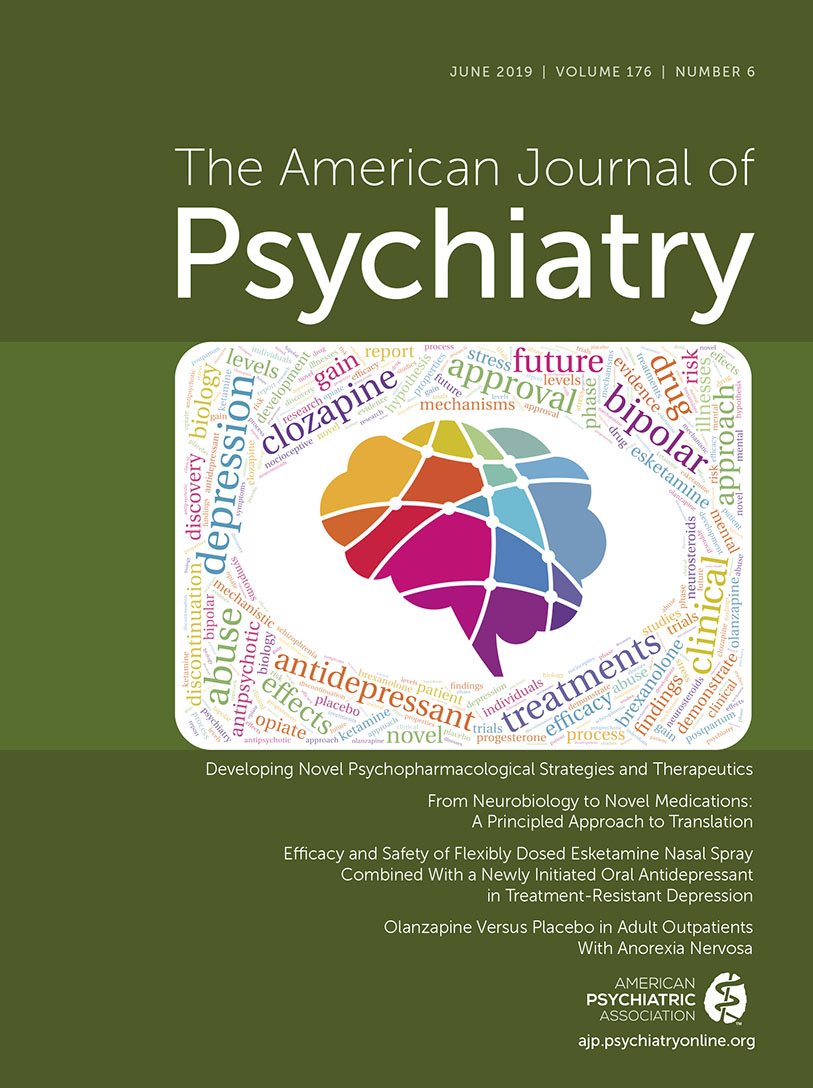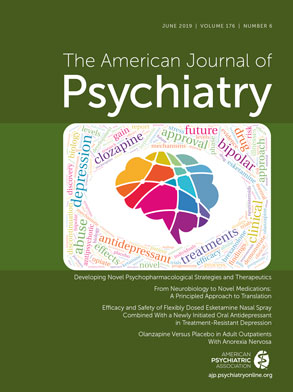The field of psychiatry faces tremendous challenges. The illnesses we seek to treat are among the most burdensome to individuals, families, and communities. These illnesses are challenging to diagnose, as laboratory tests and other biomarkers have thus far proven unhelpful. The treatments we have to offer are sometimes miraculously successful, but all too often lack efficacy, cause side effects, or fail to keep our patients in recovery.
Yet, the rapid pace of science over the past decade gives us many reasons to be hopeful. Genetic discoveries, following on the completion of the human genome project and resulting from international collaborations and data sharing standards, have revealed hundreds of genes or genomic locations robustly linked to schizophrenia, bipolar disorder, depression, autism, and other disorders. Advances in neurotechnology, facilitated by years of investment in basic neuroscience, have enabled the interrogation of the neural circuit underpinnings of complex behavior with an exquisite degree of detail. And advances in computational science and information technology are dramatically invigorating our clinical sciences, enabling researchers to use ever more sophisticated approaches to measuring the consequences of mental illnesses and parsing their heterogeneity. At their core, these advances are a promissory note that better diagnostics and transformative treatments are to come in the future.
But what about now? Patients, families, and communities bearing the burden of mental illnesses in the here and now deserve continued progress even while we wait for this long-promised future. Standing in the way of such progress is the complexity of the biological problem that faces us. The brain, the organ from which the symptoms of mental illness emanate, is the most complex biological system, even ignoring the additional complexity engendered by the brain’s interactions with the gut, the immune system, and the material, psychological, and social environment. This complexity compounds the heterogeneity of mental illnesses and belies quick explanations or simple fixes. These and other unfortunate truths hinder progress, leading to the oft-heard refrain that for all that genetics, neurobiology, and computation have to offer, psychiatric research has nothing to show for it.
This refrain is no longer accurate. The exception that has disproven the rule is the recent approval by the U.S. Food and Drug Administration (FDA) of brexanolone, the first-ever approved medication for postpartum depression and one of two recently approved antidepressants with completely novel mechanisms. In brexanolone, we now have a drug that derives its provenance directly from neuroscience. Like all progress in science, its success took time, relied on luck, and came in fits and starts. But it is useful to consider its path from laboratory to clinic as we contemplate how to encourage continued innovation in psychopharmacology.
Laying the Foundation: Basic Neuroscience
The story of brexanolone begins in the early 1940s. Hans Selye, a biochemist at McGill University, discovered and characterized a class of molecules related to progesterone that appeared to affect the central nervous system and were capable of producing sleep and anesthesia (
1). The subsequent recognition that naturally occurring metabolites of progesterone were actively produced in the brain intensified efforts to understand how these neurosteroids exerted their effects. National Institute of Mental Health (NIMH) scientists Maria Majewska and Steven Paul, together with others in the NIMH and National Institute of Neurological Disorders and Stroke Intramural Research Programs, showed that these neurosteroids induced anesthesia by enhancing the actions of GABA, the principal inhibitory neurotransmitter in the brain (
2). Subsequent research showed that there were several naturally produced neurosteroids that all work through GABA receptors, some of which enhance GABA action and others which reduce it (
3).
Basic descriptions of the brain and its inner workings are the first step toward drug discovery. Brexanolone is a formulation of allopregnanolone, one of the neurosteroids characterized in this early work. Without these basic descriptions of endogenous neurosteroids and their molecular- and circuit-level effects, the entire brexanolone story just doesn’t exist. Today’s neuroscience focuses on much more than just neurotransmitters and their receptors: it seeks also to understand the molecular machinery of the cells of the nervous system; the circuits these cells form and how they form these circuits through development; the role of these circuits in behavior; and the homeostatic and neuroplastic mechanisms that maintain their functional state. We don’t know which of these mechanisms will yield the next breakthrough treatment. Accordingly, we must continue to invest in research that seeks to further our understanding of how the brain works.
Next Steps: Disease-Relevant Biology
Since steroid hormones, in general, are often produced during stressful periods, Dr. Paul decided to test whether neurosteroids were relevant to the biology of stress. In a series of papers that came out of his lab at NIMH, Dr. Paul and others showed that production of neurosteroids was indeed induced by stress (
4). Subsequent work by Istvan Mody, Charles Zorumski, and others demonstrated that certain inhibitory neurosteroids, including allopregnanolone, were important for reducing the adverse effects of stress on the behavior and physiology of laboratory animals (
5,
6). Together, these findings suggested that neurosteroids like allopregnanolone were part of the brain’s response to stressful events.
A final series of studies examined the role of neurosteroids specifically in postpartum depression. Allopregnanolone and other neurosteroids are synthesized from progesterone. Since progesterone levels rise during pregnancy and drop rapidly at the time of delivery, so too do the levels of these neurosteroids. These findings led to the hypothesis that neurosteroids might play a role in postpartum depression, and evidence in support of this hypothesis was found in laboratory animal models in which stress was observed to induce behavioral changes in the early postpartum period. Giving the animals supplemental allopregnanolone reversed the behavioral changes (
5,
7).
This work moved beyond basic science, targeting the biological mechanisms underlying functions of the brain directly relevant to psychiatry. Stress biology and the factors governing brain responses to stress clearly play important roles in mental illness, and postpartum depression is a serious illness with major consequences for mothers and their families. By demonstrating, first, correlations between stress effects, pregnancy, and neurosteroids, and then testing the causal relationship between neurosteroid action and the effects of stress in the postpartum period, these studies led to a mechanistic hypothesis regarding the potential actions of allopregnanolone in a disease with tremendous public health relevance.
Into Humans: Causal Hypothesis Testing
The demonstration of a mechanistic link to postpartum depression using animal models raised the possibility that allopregnanolone might be useful in postpartum depression. The next step was to test the causal effect of allopregnanolone supplementation in humans through a clinical trial. This is a step where many previous attempts at translation have failed. Crucially, the basic mechanistic fact in the animal model—a decrease in allopregnanolone in the postpartum period—was an established fact in humans as well. This raised the chances of success. Successful clinical trials in postpartum depression conducted by Sage Pharmaceuticals (
8,
9) led to brexanolone’s approval by the FDA as the first drug specifically designed to treat postpartum depression.
Gathering evidence linking preclinical mechanistic studies in animals to illness states in human beings is a crucial step in reducing the risk of failure in clinical trials. All too often, this step in drug development has been overlooked. But the evolutionary distance between model organisms and humans, and the lack of construct validity between psychiatric illnesses and the preclinical models thereof, makes this step all the more important. Fundamental biological mechanisms thought to underlie mental illness must be examined in humans, and the capacity of interventions to target these mechanisms must be verified in individuals with these illnesses during the drug development process. This focus on mechanistic targets is at the heart of the NIMH experimental therapeutics approach (
10), which requires proof of target engagement in tests of clinical efficacy, aiming squarely at this crucial translational step.
Building on Success: The Future of Drug Discovery
There are multiple approaches to drug discovery in psychiatry. Caution must be exercised not to assume that too much has been learned from a single success story. Alternative approaches may also yield treatments with novel mechanisms of action. SEP-3638456, a putative antipsychotic currently under development by Sunovion, does not work through dopamine 2 receptors and was discovered using a behavioral screening approach (
11). Serendipitous clinical observations—like those that led to the demonstration that ketamine, and subsequently esketamine, are effective antidepressants—may also occasionally succeed. But the principled approach of following neurobiological clues from basic science through translational work to mechanistically driven clinical trials, as exemplified by brexanolone’s successful translation from bench to bedside, illustrates a powerful path that has too often been maligned as ineffective for psychiatric illnesses. The rapid pace of genetics, neural circuitry, and computational approaches will only increase the number of these neurobiological clues. Exploiting the translational pathway to turn these clues into the next generation of transformative treatments is crucial.
To this end, NIMH has a number of tools to assist in the translational pathway. These include the NIMH Drug Discovery and Clinical Therapeutics Program, which supports research to design and develop novel therapeutic agents for the treatment of mental illnesses, as well as the NIMH Psychoactive Drug Screening Program, which provides the research community with access to broad screening capabilities in the form of pharmacological and functional assays.
The focus of these and other drug development pipeline programs is on mechanistic translation. Accordingly, an important component of this translation is the development of biomarkers that permit the testing of mechanistic hypotheses in humans. For any given hypothesis-driven clinical trial, a mechanistic biomarker would have several advantages. First, it could provide a measure of target engagement, ensuring that the trial would provide a test of the mechanistic hypothesis, regardless of whether it had a clinical effect. Second, it could enable selection of clinical trial participants for specific individuals whose profiles suggest alterations in that mechanism, suggesting that they might be most likely to respond to a therapy targeting it. And third, it might provide a readout of effectiveness that precedes and predicts clinical outcome.
From neurobiology through translational science and into biomarker-guided mechanistic clinical trials, NIMH’s drug development approach is aimed at maximizing public investment in drug development, ensuring that scientific progress continues throughout the translational process and facilitating implementation of effective treatments through public and private partnerships.

